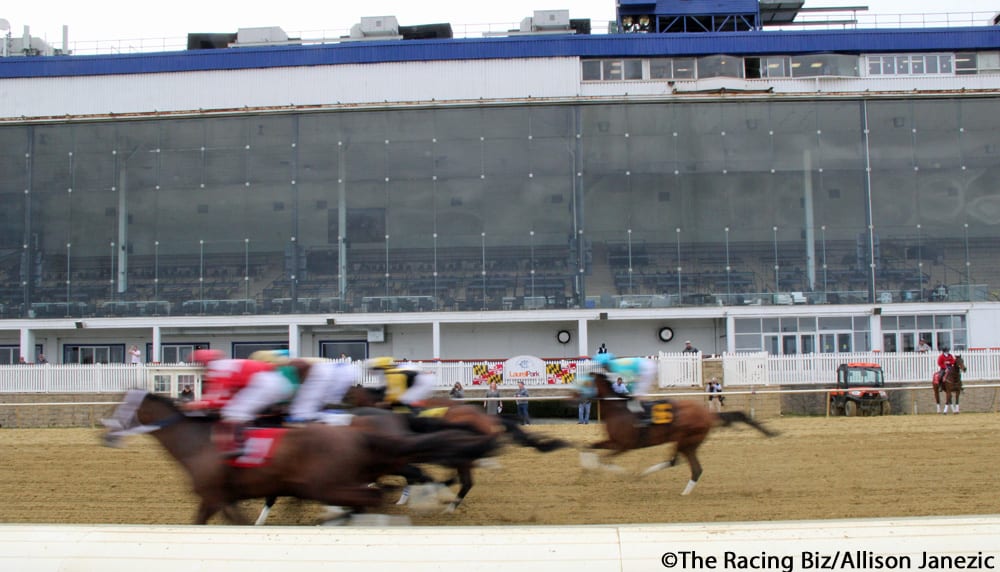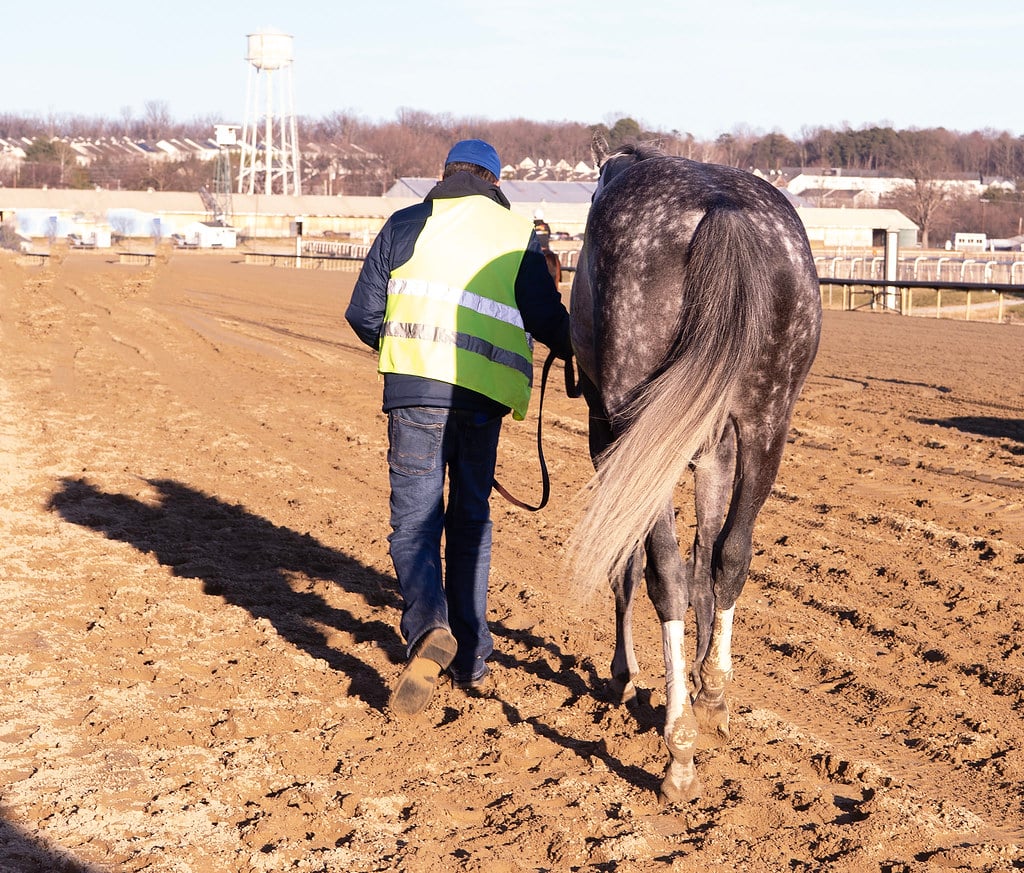[et_pb_section bb_built=”1″ admin_label=”section”][et_pb_row admin_label=”row” background_position=”top_left” background_repeat=”repeat” background_size=”initial”][et_pb_column type=”4_4″][et_pb_text background_layout=”light” text_orientation=”left” use_border_color=”off” border_color=”#ffffff” border_style=”solid” module_alignment=”left” background_position=”top_left” background_repeat=”repeat” background_size=”initial”]
Photo by Laurie Asseo.
From an Association of Racing Commissioners International release
Three perspectives on how to achieve North American uniformity of thoroughbred racing regulations were presented on Thursday’s second day of the Association of Racing Commissioners International’s 84th annual conference on Equine Welfare and Racing Integrity.
James Gagliano, president of The Jockey Club, batted leadoff and pushed for a proposed federal bill that would put control of drug testing in the hands of the United States Anti-Doping Agency — a move widely opposed by the major horsemen’s associations, most racing regulators and privately by many racetracks.
Alan Foreman, chairman and CEO of the Thoroughbred Horsemen’s Association, countered that the Interstate Compact on Anti-Doping and Drug-Testing Standards spearheaded by Mid-Atlantic states is a template for achieving the uniformity that counts without adding a costly and unnecessary bureaucratic layer.
The New Jersey Racing Commission, which is part of the Mid-Atlantic alliance, adopted a third approach by changing its laws so that the ARCI model rules automatically go into effect in the Garden State — a method known as “by reference.” The model rules are created and approved by the ARCI board to provide the blueprint for individual jurisdictions in the regulation of the sport.
Gagliano painted a picture of an American industry that needs H.R. 2651, titled the Horseracing Integrity Act, to stay viable internationally by establishing a single authority to create and implement a national uniform medication program while putting medication oversight in the hands of USADA, which does not do actual testing but contracts with existing labs.
“Until and unless states agree to adopt the ARCI model rules by reference, all effective on the same date and so long as the National Uniform Medication Program remains a living document, we most assuredly will never achieve uniformity in our current regulatory system,” he said.
Foreman said there is uniformity where it matters.
“We drug test, we identify prohibited substances and don’t permit prohibited substances,” he said, adding that “the enforcement might be different … But ladies and gentlemen, we are uniform. What we’ve tried to do over the years — and some people beat us up for this — is we try to do it better.”
Foreman said that 97 percent of betting on horse racing in America comes on states that have adopted the ARCI/RMTC Controlled Therapeutic Substances list.
“So when they tell you that we’re not uniform, put it in perspective as to who is not doing this, and does it really matter?” he said.
Foreman said the Mid-Atlantic states represent 40 percent on the national handle on a daily basis as the nation’s largest concentration of racing, including at times when 12 thoroughbred tracks within 200 miles might run at the same time. As such, the Mid-Atlantic has led the charge toward uniformity, with its regional regulatory group mushrooming and creating what has become a potentially national compact in the Interstate Compact on Anti-Doping and Drug-Testing Standards, he said.
“Everyone who has skin in the game at this segment of our business, and they’re not there to bring their agendas,” he said of the current working group. “They are there to help collectively to move us forward to see if we’re complying with the national program. Are there next steps to take? What are the problems we need to address?”
Foreman noted a 23-percent reduction in positive findings among post-race drug tests in 2017 from 2016 in the region and a 27-percent decrease in equine fatalities from 2013 to 2017. He said that four years ago only a handful of racing laboratories had national accreditation, but that today only one state’s lab is not accredited.
“You hear all this stuff in the media about chaos and confusion and lack of uniformity,” he said. “… Is that chaos? Is that confusion? That’s compliance with a program.
“A compact is a streamlined way of getting us all collectively to adopt a rule and implement it at one time. It requires legislation in every state that wants to join. Maryland became the first state last week to unanimously adopt the compact… I expect by end of the year we’ll have Delaware, New Jersey, New York; and West Virginia will be next year because we’re beyond their (legislative) deadline…. The compact is not being created to become this new rule-making body.”
Compacts don’t have “opt-out” provisions, but the Mid-Atlantic’s compact — open to any state to join — requires that 80 percent of member jurisdictions vote in favor for a compact rule to pass.
“It’s a protection device to insure there is at least the ability to discuss and send back for further consideration a proposed rule,” Foreman said. “… It is designed as the next logical step, and that is: If you have a consensus and want to make a change, we can do it one time and do it quickly. Our horsemen want it, our regulators want it. It’s in everybody’s best interest, and it’s totally non-threatening.
“The Mid-Atlantic has agreed to do this. And if nobody else does, that’s fine. This is not one of these ‘OK, we’ve got a national thing here and because Nevada and Wyoming didn’t join you don’t have a national compact and we’ve got to run to the federal government because they’re the only ones who are going to get it done.’ We’re going to do it for the people for whom it’s important.”
Ed Martin, ARCI’s chief executive officer, cited states, including those outside the Mid-Atlantic, that have approved various forms of enabling legislations to join a compact.
“There are more states looking at it for next year, and you are seeing some concrete advancement on this concept,” he said. “It’s not a theoretical.”
Judy Nason, deputy director of the New Jersey Racing Commission, said her state looks forward to being in the compact. In pursuit of uniformity in 2014, New Jersey opted to adopt ARCI’s model rules by reference.
“When ARCI updates the rules and amends them, New Jersey automatically incorporates those amendments and supplementations by reference,” she said. “It keeps us current with the work of this body.”
Eric Hamelback, CEO of the National Horsemen’s Benevolent and Protective Association that fiercely opposes the federal bill, asked Gagliano from the audience about his repeated references to international racing and Grade 1 stakes.
“Are you talking about a class separation in integrity and a variation in testing?” Hamelback said. “Because you distinctly left out what I would consider 95 percent of racing…. We all agree essentially that North American racing is the leader in the world. So why does the international comparison continue to be utilized?”
Foreman added that in the Mid-Atlantic, every lab tests to the level of graded-stakes protocols.
Martin said everyone agrees “on most aspects of where we need to be.
“There is a lot of money being spent on people to argue from both sides of this issue. I sit on the board of the RMTC, and I look at the amount of money committed to research. I look at the number of strains of EPO (Erythropoietin, used in blood doping) that nobody in the world — in horse racing lab or human — can detect. And where our challenge is with emerging threats, the amount of money we’re spending disagreeing over what route we should take (to uniformity), if that money was given to the RMTC to do research, we might be better off.
“This is a tough sport to police, whether you’re in California, New York, Washington, France, Great Britain. We need to collectively figure a way to pool certain resources and focus in on real threats we have to the integrity of this sport as well as the health and welfare of our horses. There might be some times when we just have to agree to disagree. But in the scheme of things, they are relatively minor.”
[/et_pb_text][et_pb_text background_layout=”light” text_orientation=”left” use_border_color=”off” border_color=”#ffffff” border_style=”solid” module_alignment=”left” background_position=”top_left” background_repeat=”repeat” background_size=”initial”]













